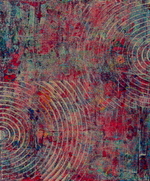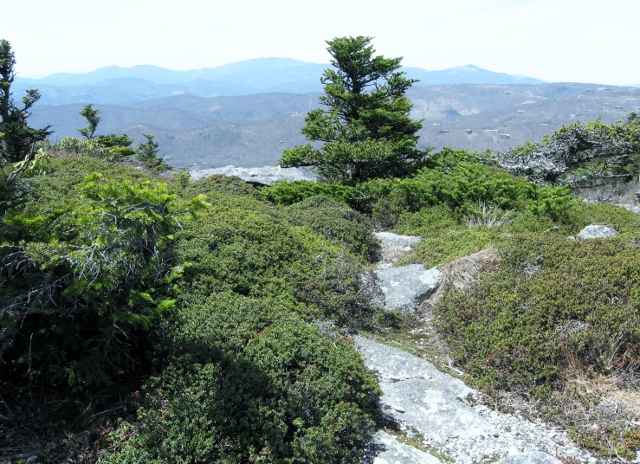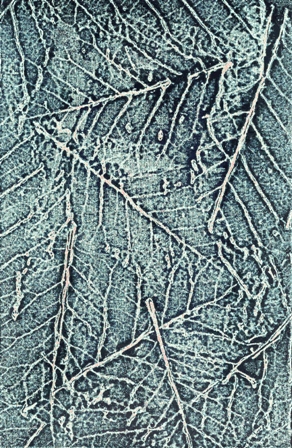 In recent years I've taken creative leaps farther into the intersection between my artist’s books and science topics. I’m an amateur naturalist, a science enthusiast, and a trained social scientist, as well as a book artist and writer. As suggested by the Curious Pursuits imprint for my artist’s books, I identify with the inquisitive impulse that drives scientific explorations, including small-scale, everyday ones. In the creative process, I, like many scientists, value systematic inquiry that’s ever open to serendipity.
In recent years I've taken creative leaps farther into the intersection between my artist’s books and science topics. I’m an amateur naturalist, a science enthusiast, and a trained social scientist, as well as a book artist and writer. As suggested by the Curious Pursuits imprint for my artist’s books, I identify with the inquisitive impulse that drives scientific explorations, including small-scale, everyday ones. In the creative process, I, like many scientists, value systematic inquiry that’s ever open to serendipity.
One organization that has inspired me is Art & Science Collaborations, Inc., a fascinating network of artists and scientists who explore shared interests from many angles. The ASCI website offers a wealth of resources, and I'm deeply honored to have been the ASCI "Featured Member" for June 2014. Also gratifying was the inclusion of my poem "On the Whole," about artists' and scientists' intersecting perspectives, in Sci-Art in America's 2nd-anniversary issue (August 2015).
On the Whole
Entering each day’s mundane thresholds
into the mysterious and profound, we take up
pens, palettes, petri dishes, lenses to delineate,
illuminate the minute and fleeting, the seemingly
solid and immutable. Driven by questions and hopes,
we eschew single angles and celebrate synergies exploding
from explorations. Some pursue explanatory details,
data upon which to build vocabularies and theories,
exchange insights, push farther into unknowns. Others
pursue revelatory expressions of depths intuited
or observed, universal and uniquely experienced.
Searchers all, we let curiosity inexorably push us to
add senses and subsenses to every definition, pull us
toward shared wondering and the sharing of wonder.
My bookshelves bulge not only with poetry books but also with nonfiction books about neuroscience, geology, speleology, botany, and other science subjects (as consequence, in part, of having edited nonfiction trade books for many years). Often, the curiosity that leads me to check out certain science facts leads me to an artist’s book idea. For instance, such a process has happened time and again as I’ve continued learning about Mammoth Cave, bats, karst landscapes, and cave hydrology. (Many of the resulting books are described in the Portfolio and Books & Tales parts of this website.)
In other cases, I’ve begun with some creative vision and then realized how crucial accurate details would be to its fruition. This would apply to certain of my artist’s books involving the hydrologic cycle, cartography, and optical processes. Two topics I’ve explored—and will revisit—in my artist’s books and poems is wonder as the “essential sense” (an homage to the writings of ecologist and scientist Rachel Carson)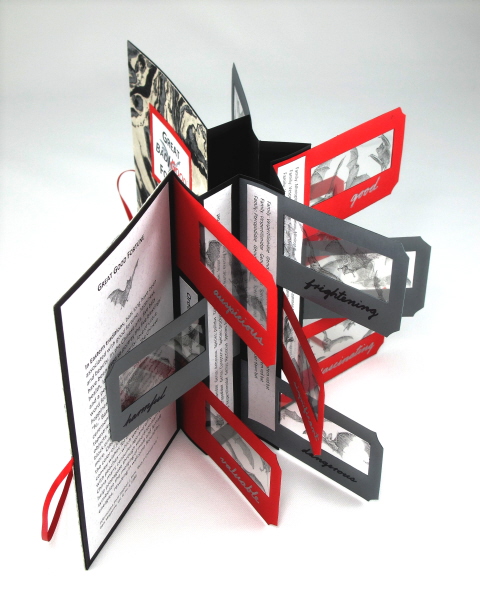 and the interplay between complexity and simplicity in natural processes. Lunar cycles, the properties of glass, and the migration patterns of monarch butterflies have been among my poem subjects. The natural world is inextricably linked to my creative efforts, and I revel in learning details that can help give texture, vividness, and shape to what I’ve envisioned.
and the interplay between complexity and simplicity in natural processes. Lunar cycles, the properties of glass, and the migration patterns of monarch butterflies have been among my poem subjects. The natural world is inextricably linked to my creative efforts, and I revel in learning details that can help give texture, vividness, and shape to what I’ve envisioned.
Scientists' work frequently intrigues and inspires me, as do my own observations and explorations while in natural settings. I enjoy supporting science education through artistic activities and learning from others interested in the realm of "sci-art." In November 2011, for example, I offered a bookmaking workshop at the North Carolina Science Teachers Association, I offered a Professional Development Institute, and I look forward to more networking with science teachers. If you also have sci-art interests, I’d enjoy hearing from you!

Many of my books relate to nature, such as Blue Ridge Bounty, an exploration of the tree species near the Blue Ridge Parkway:
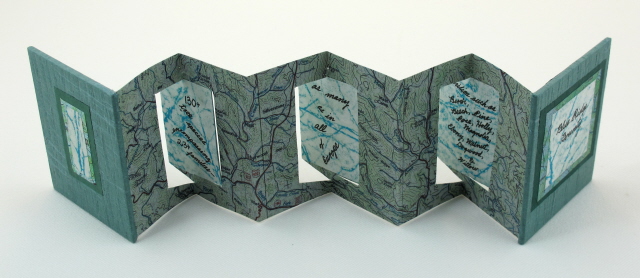
One of my books, Hidden Horizons: Ground for Growth, offers readers glimpses into many aspects of soil horizons. Here's one view, and another appears on the News webpage:
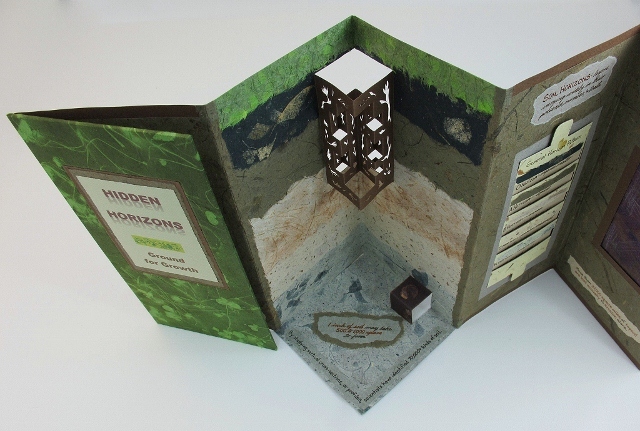
Nature also has inspired many of my poems, including this one, which originally appeared in Heartstone:
Mnemonics
I trust the memories of mountains
as surely as do hawks circling
on updrafts, white pines swaying
atop hills, deer striking streamside
poses. Animate, organic, I join
thistle, laurel, huckleberry, fern
in rhythms of light and dark
free from illusions about what
rises and sets. Each time I sojourn
to this overlook, peaks and valleys
teach pulse and breath the pace
of epochs, eras, eons, while eyes
learn from layered rocks how
pressures have filled real time
and why nomina dubia exist.
Another science-related interest I've explored in poems is the physical properties of glass, as in the following poem that first appeared in Pembroke Magazine:
Fulgurites at Jockey’s Ridge
Summer afternoon, sand dunes spread
creamy heights toward a steel-gray sky.
tiny figures scale the mountains and leave
footprints drifting behind. Clouds darken
and billow, breezes stiffen, wind-blown
sand inches down my shirt. Aren’t the walkers
watching? Several turn toward my anxious
eyes and hasten back to harbor; a few
defiantly saunter. Huge raindrops slow-
dance along the front and the air crackles
with certainties. Now, even the stragglers
migrate with me into our driven shelters.
Some start engines and flee, but most of us
secure doors and windows, ignore the wipers.
Within moments we cower as dunes, drops,
cloud edges burst into blinding white and
thunder’s blast obliterates rainy clatter.
Stunned, we hunker down, squeeze eyes closed
as lightning bolts strike ground. When the storm,
once weakened, advances north, we open doors,
then test the soggy footing. While others stand
and stretch, I sprint like an unleashed retriever.
Somewhere, buried, may lie long, thin, snaking
tubes of sand recast—silicates flashed into glass.
I have read the posted notices: All such finds
must be surrendered to the proper authorities.
As gulls soar overhead, my strides widen.
Nonfiction Trade-Book Editing
As mentioned earlier, my editing of nonfiction trade books (that is, ones targeted to a general audience) has involved a variety of science-related topics, and my clients have included such publishers as BasicBooks/HarperCollins, Oxford University Press, Addison-Wesley, and Newmarket. The enjoyable challenge has been for me to respond to each manuscript as a nonscientist eager to understand science-related specifics crucial to each topic. Among the books I've learned so much from while doing the editorial work are these:
Doane & Diamond, Affect and Attachment in the Family
Gardner, Creating Minds: An Anatomy of Creativity as Seen through the Lives of Freud, Einstein, Picasso,
Leading Minds: An Anatomy of Leadership (which includes a chapter on J. Robert Oppenheimer)
Intelligence Reframed: Multiple Intelligences for the Twenty-first Century
Heymann (ed.), Global Inequalities at Work: Work’s Impact on the Health of Individuals, Families, and Societies
Johnson, Out of Bedlam: The Truth about Deinstitutionalization
Lewis, Mining the Sky: Untold Riches from the Asteroids, Comets, and Planets
Rothman, Strangers at the Bedside: A History of How Law and Bioethics Transformed Medical Decision Making
Steingraber, Living Downstream: A Scientist's Personal Investigation of Cancer and the Environment
Tietelman, Gene Dreams: Wall Street, Academia, and the Rise of Biotechnology
Weisskopf, The Joy of Insight: Passions of a Physicist
